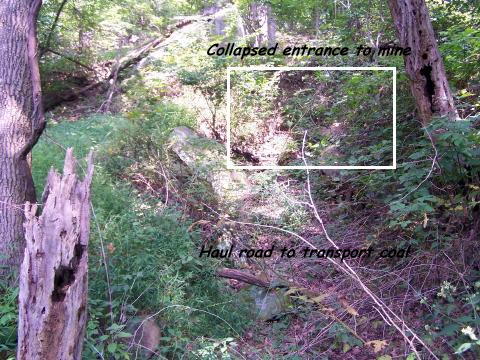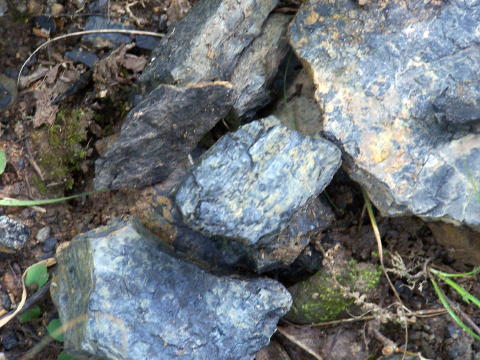| DON'T TELL THE STATE TAX DEPARTMENT

Alex Buck's mine was likely developed before the Civil War on
a steep hillside above Barnes Run, a short distance from Hur
By Bob Weaver
During the 1800s and early 1900s, an early Calhoun map denotes several family or community hand dug coal mines, the coal was used for the heating of homes.
Calhoun has never been considered a coal county, but shale-like coal can be found around the county, although there are deep deposits under Washington District.
Alexander Buck, a Civil War vet, who lived on the Buck Ridge high above Barnes Run not far from the Hardman manor house, discovered a small outcropping of coal in the late 1800s below his house on a steep hillside.
Buck, a blind man, who later married widow Kisare "Kissie" Slider Riggs, went about developing a small mine shaft into the hillside, digging out a pathway to haul the coal, likely by horse and sled.

A few lumps of coal can still be found near the mine entrance
Calhoun's deep coal deposits have long been declared unmineable, although the State Tax Department made an effort to tax them in 2001.
The effort was fought back by the Calhoun Commission.
See 2001 article  UNMINEABLE COAL TAXED IN SOUTHERN CALHOUN - "It Is Absolutely Unfair To Tax These Deposits"
The coal in southern Calhoun is several hundred feet down.
Coal researchers say the depth of the coal and the nature of the seams makes it impractical, although estimates in the early part of 1900 indicate there is 300 million tons of Bakersfield coal and 100 million tons of Pittsburgh coal under southern Calhoun.
A state official told the Calhoun Commission in 2001 that only "beyond extreme" mountain top removal could be used to extract it.
Alex, however, made use of the low-class shale coal near his house, warming his family in winter.
Buck rests in the Hur Cemetery.
2009
| 


